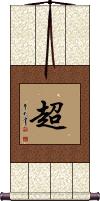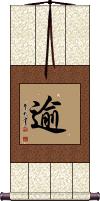Many custom options...
And formats...

Transcend in Chinese / Japanese...
Buy a Transcend calligraphy wall scroll here!
Personalize your custom “Transcend” project by clicking the button next to your favorite “Transcend” title below...
Overcome / Surpass / Rise Above
In Chinese, Japanese Kanji, and old Korean Hanja, 超越 means to overcome, surpass, transcendence, excel, exceed, go beyond, rise above, or transcend.
Super
超 is “super” in Chinese and Japanese Kanji.
It can also mean: to exceed; to overtake; to surpass; to transcend; to pass; to cross; to jump over. It can also be a suffix like ultra- hyper- super-
From Sanskrit, this can be the Buddhist “vikrama,” meaning to leap over; surpass; exempt from; to save.
Beyond / Exceed / Surpass
逾 means: to exceed; to go beyond; to transcend; to cross over; to jump over.
You'll see this character used in Buddhism (same meaning).
Technically, this single character is a Japanese word but is seldom used as a single Kanji in modern Japanese.
These search terms might be related to Transcend:
Beyond / Exceed / Surpass
Overcome / Surpass / Rise Above
Not the results for transcend that you were looking for?
Below are some entries from our dictionary that may match your transcend search...
| Characters If shown, 2nd row is Simp. Chinese |
Pronunciation Romanization |
Simple Dictionary Definition |
超 see styles |
chāo chao1 ch`ao chao wataru わたる |
More info & calligraphy: Super(prefix) (1) (ちょう only) super-; ultra-; hyper-; extreme; (prefix) (2) (colloquialism) extremely; really; totally; absolutely; (suffix noun) (3) (ちょう only) (after a number or counter) over; more than; (given name) Wataru vikrama. Leap over, surpass; exempt from; to save.; Two ways of passing over (to bliss): 豎 the lengthwise, or long way (of Hīnayāna); and 橫 the crosswise, or short way of Mahāyāna. |
逾 see styles |
yú yu2 yü yu |
More info & calligraphy: Beyond / Exceed / SurpassTo pass over, exceed. |
超越 see styles |
chāo yuè chao1 yue4 ch`ao yüeh chao yüeh chouetsu / choetsu ちょうえつ |
More info & calligraphy: Overcome / Surpass / Rise Above(n,vs,vi) transcendence; transcendency Surpassing, supreme; to pass over, be exempt from. |
絕名 绝名 see styles |
jué míng jue2 ming2 chüeh ming zetsumyō |
to transcend names |
翻越 see styles |
fān yuè fan1 yue4 fan yüeh |
to cross; to surmount; to transcend |
賢聖 贤圣 see styles |
xián shèng xian2 sheng4 hsien sheng kensei / kense けんせい |
(personal name) Kensei Those who are noted for goodness, and those who are also noted for wisdom, or insight; the xian are still of ordinary human standard, the sheng transcend them in wisdom and character; the attainments from 見道 upwards are those of the sheng; the xian is on the moral plane, and has not eliminated illusion; the sheng has cut of illusion and has insight into absolute reality. The Mahāyāna has three stages for the xian and ten for the sheng; the Hīnayāna has seven for each. |
超度 see styles |
chāo dù chao1 du4 ch`ao tu chao tu chōdo |
to surpass; to transcend; to perform religious ceremonies to help the soul find peace to transcend |
超脫 超脱 see styles |
chāo tuō chao1 tuo1 ch`ao t`o chao to |
to stand aloof; to be detached from; to transcend worldliness; untrammeled; unconventional See: 超脱 |
越度 see styles |
yuè dù yue4 du4 yüeh tu koshido こしど |
mistake; error; fault; slip; blunder; omission; oversight; lapse; (surname) Koshido to transcend |
越過 越过 see styles |
yuè guò yue4 guo4 yüeh kuo |
to cross over; to transcend; to cover distance; to overcome; to rise above |
跳出 see styles |
tiào chū tiao4 chu1 t`iao ch`u tiao chu chōshutsu |
to jump out; fig. to appear suddenly to transcend |
跳脫 跳脱 see styles |
tiào tuō tiao4 tuo1 t`iao t`o tiao to |
(Tw) to break free of (outmoded ways of thinking etc); to move beyond; to transcend |
超名相 see styles |
chāo míng xiàng chao1 ming2 xiang4 ch`ao ming hsiang chao ming hsiang chōmyōsō |
to transcend name and form |
壞本絕本 坏本绝本 see styles |
huài běn jué běn huai4 ben3 jue2 ben3 huai pen chüeh pen e hon zetsu hon |
eradicate and transcend [the idea of] fundamental [Being] |
昇出色心 see styles |
shēng chū sè xīn sheng1 chu1 se4 xin1 sheng ch`u se hsin sheng chu se hsin shōshutsu shiki shin |
transcend body and mind |
超宗越格 see styles |
chāo zōng yuè gé chao1 zong1 yue4 ge2 ch`ao tsung yüeh ko chao tsung yüeh ko chōshū okkyaku |
transcend the tenets and go beyond the standards |
超過影像 超过影像 see styles |
chāo guō yǐng xiàng chao1 guo1 ying3 xiang4 ch`ao kuo ying hsiang chao kuo ying hsiang chōka yōzō |
to transcend projections of consciousness |
立ち越える see styles |
tachikoeru たちこえる |
(v1,vi) (1) (See 立ち・たち・7) to rise above; to transcend; (v1,vi) (2) (See 立ち・たち・7) to surpass; to be superior to; (v1,vi) (3) to go out; to come around |
離蓋趣愛言教 离盖趣爱言教 see styles |
lí gài qù ài yán jiào li2 gai4 qu4 ai4 yan2 jiao4 li kai ch`ü ai yen chiao li kai chü ai yen chiao rikai shuai gonkyō |
discourses that free one from obscurations and transcend attachment |
The following table may be helpful for those studying Chinese or Japanese...
| Title | Characters | Romaji (Romanized Japanese) | Various forms of Romanized Chinese | |
| Overcome Surpass Rise Above | 超越 | chou etsu / chouetsu / cho etsu | chāo yuè / chao1 yue4 / chao yue / chaoyue | ch`ao yüeh / chaoyüeh / chao yüeh |
| Super | 超 | chou / cho | chāo / chao1 / chao | ch`ao / chao |
| Beyond Exceed Surpass | 逾 | yu | yú / yu2 / yu | yü |
Successful Chinese Character and Japanese Kanji calligraphy searches within the last few hours...






